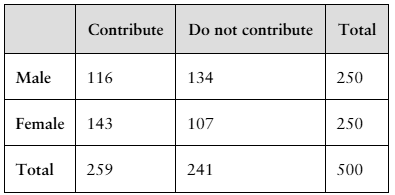Table of contents
- 1. Intro to Stats and Collecting Data55m
- 2. Describing Data with Tables and Graphs1h 55m
- 3. Describing Data Numerically1h 45m
- 4. Probability2h 16m
- 5. Binomial Distribution & Discrete Random Variables2h 33m
- 6. Normal Distribution and Continuous Random Variables1h 38m
- 7. Sampling Distributions & Confidence Intervals: Mean1h 3m
- 8. Sampling Distributions & Confidence Intervals: Proportion1h 12m
- 9. Hypothesis Testing for One Sample1h 1m
- 10. Hypothesis Testing for Two Samples2h 8m
- 11. Correlation48m
- 12. Regression1h 4m
- 13. Chi-Square Tests & Goodness of Fit1h 20m
- 14. ANOVA1h 0m
4. Probability
Multiplication Rule: Independent Events
Problem 3.2.8b
Textbook Question
Finding Conditional Probabilities In Exercises 7 and 8, use the table to find each conditional probability.
8. Retirement Savings The table shows the results of a survey in which 250 male and 250 female workers ages 25 to 64 were asked if they contribute to a retirement savings plan at
work.
b. Find the probability that a randomly selected worker is female, given that the worker contributes to a retirement savings plan at work.

 Verified step by step guidance
Verified step by step guidance1
Step 1: Understand the problem. We are tasked with finding the conditional probability that a randomly selected worker is female, given that the worker contributes to a retirement savings plan at work. Conditional probability is calculated using the formula P(A|B) = P(A ‚ą© B) / P(B), where P(A|B) is the probability of A given B.
Step 2: Identify the relevant data from the table. The total number of workers who contribute to a retirement savings plan is 259 (this is P(B)). Out of these, the number of female workers who contribute is 143 (this is P(A ‚ą© B)).
Step 3: Write the formula for conditional probability. Using the formula P(A|B) = P(A ‚ą© B) / P(B), substitute the values: P(Female | Contribute) = Number of females who contribute / Total number of workers who contribute.
Step 4: Substitute the values into the formula. From the table, the number of females who contribute is 143, and the total number of workers who contribute is 259. So, P(Female | Contribute) = 143 / 259.
Step 5: Simplify the fraction if needed. The result will give the conditional probability that a randomly selected worker is female, given that they contribute to a retirement savings plan.
 Verified video answer for a similar problem:
Verified video answer for a similar problem:This video solution was recommended by our tutors as helpful for the problem above
Video duration:
2mPlay a video:
Was this helpful?

 5:54m
5:54mWatch next
Master Probability of Multiple Independent Events with a bite sized video explanation from Patrick
Start learningRelated Videos
Related Practice

